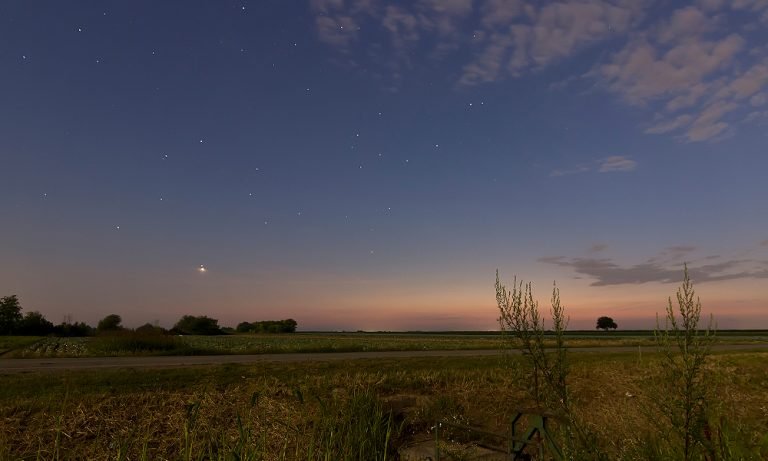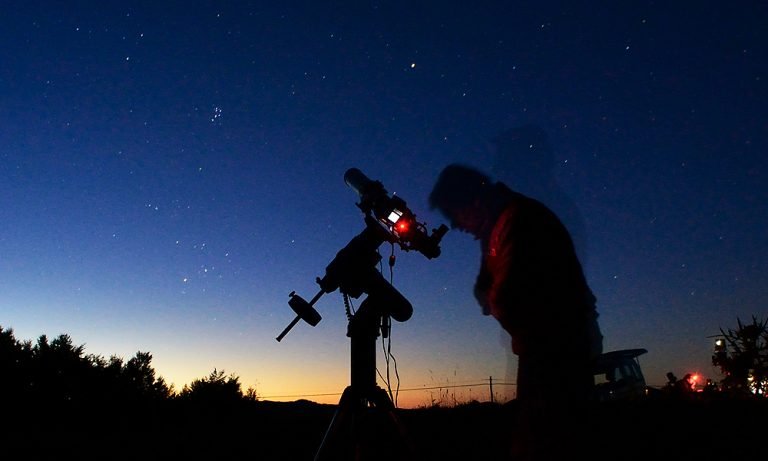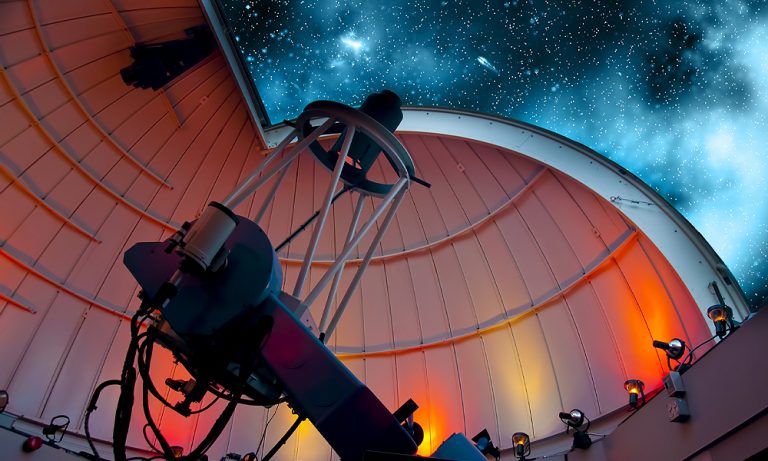5 Best Solar Telescopes in 2024 [to Observe The Sun]
Are you hooked on planet, moon, and star-gazing? At some point, the question will arise – how do I observe the sun? After all, it is our closest star and deserves attention.
Most people know that looking directly at the sun is a no-go. But, many people are not aware that you need a special telescope to view the sun.
In this article, we are taking astronomy out of the night sky and into the daylight. We have reviewed 5 best solar telescopes, giving a summary of the main features. This will help you make an informed decision when deciding on which solar telescope is best for you.
We Recommend
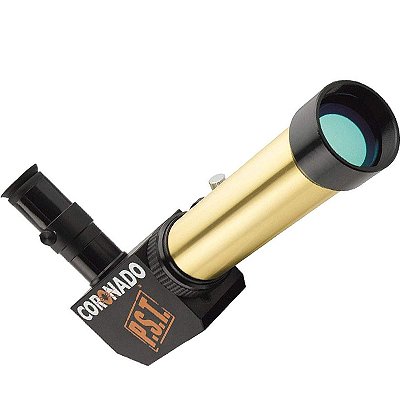
Best value for money
Meade Instruments
PST Cornado
Best budget option
Sky-Watcher
Virtuoso Telescope
Best for the money
Meade Instruments
0.5PST Coronado
How to observe the sun?
To observe the sun, you need a telescope that firstly protects your vision. Secondly, it must feature either a White Light Filter or a Hydrogen Alpha filter.
As a family enjoying star-gazing, I was especially concerned that my children did not damage their eyes. So, I did some investigation.
White light filters.
- Buying a scope with a White Light filter is a great choice for beginners. It is a cheaper option than Hydrogen Alpha filters.
- You can add a White Light Filter to an existing scope and turn it into a solar scope.
- The filter is usually placed over the front of the telescope and works by reducing the light that hits the eyepiece.
- With a White Light Filter, you can view the Solar photosphere and sunspots.
Hydrogen Alpha filters.
- This is a step-up from White Light Filters and better suited for hardcore fans. These scopes feature in-built Hydrogen-Alpha (Ha) filters for safe solar viewing.
- This is not a component that you can purchase separately and add to an existing scope. These filters only show the light spectrum in which the Sun has its most activity.
- You will be able to view the granulation on the Solar chromosphere. You will also see solar flares and prominences.
- Scopes with Ha filters are usually priced higher.
Can you use any telescope as a solar telescope?
You can turn many night-sky telescopes into solar telescopes by adding a solar filter. The issue is vision safety and knowing what you are doing. If your night scope comes with a solar filter, you can rest assured that it will fit properly and give you the protection you need. As a beginner, I would be hesitant to experiment and attach random filters to my scope.
Solar telescopes are made specifically for viewing the sun. Cheaper models have special filters that you attach to the front when viewing. More expensive models feature an in-built filter known as a hydrogen-alpha bandpass. This reduces the light and restricts it to the wavelength spectrum emitted by the sun.
We soon learned that with a solar filter, you will never see solar flares! My kids then responded, well in that case, why do we need a filter? The answer is simple – never, EVER, look at the sun without a filter. It can destroy your eyes.
To summarize – if you purchase a PST, Personal Solar Telescope, you will not be able to use it for night sky viewing. If you have a night-sky telescope with a solar filter, you have the best of both day and night viewing. You will, however, have less detailed views of the sun.
Important accessories for solar observation
For solar observation, there are 3 accessories that you need to consider.
Finder scope. A finder scope is an aiming device that allows you to pinpoint an object. Viewing the sun is more complex. You certainly don’t want to look directly through your scope. The Sol-Searcher finder scope helped us get started. It is safe as you don’t look through it at the sun. It works by projecting an image of the sun onto a screen.
Eyepieces and Barlow. When viewing the sun, it is important to use eyepieces designed specifically for this. They are usually optimized for viewing the sun in Hydrogen Alpha light. These eyepieces offer performance rather than a field of view, giving you clearer images with less distortion. We found a set that offers a choice of 3 eyepieces. It also includes a 2x Barlow, which increases the magnification options. For ease of transporting, the set comes in a handy carry case.
Proper Mount. Your telescope must be correctly mounted. You certainly don’t want it toppling over. You also want a mount that is lightweight and easy to set up. Some of the telescopes we reviewed have a convenient table mount. Others don’t come with a mount; we suggest the Sky-Watcher Star Adventurer Pro Pack.
The solar viewing safety etiquette
The first issue to remember when starting out as a solar astronomer –
NEVER LOOK AT THE SUN THROUGH A TELESCOPE THAT DOES NOT HAVE THE CORRECT FILTERS. YOU WILL CAUSE PERMANENT AND IRREVERSIBLE DAMAGE TO YOUR EYES. YOU WILL ALSO DAMAGE YOUR SCOPE.
Here are some other important issues to keep in mind
- Certification. Ensure that the scope is ISO and/or CE certified. These scopes are safe for solar viewing.
- No pinholes or coating errors. Don’t try to save money on solar telescopes. Cheaper models may have filters with pinholes or coating errors. This is the equivalent of viewing without a filter and is extremely dangerous.
- Snugly fitting filters. Some telescopes do not have permanently built-in filters. You need to ensure that the filter you attach is snug and tightly fitted. There must be no light leaks or gaps.
- No reflector type telescopes. Do not use reflector type telescopes. They can overheat, sustain damage, and cause injury to the user.
- Don’t use a night sky telescope. Never use your night sky telescope to view the sun unless you attach a proper filter.
- Use a finder scope. Never look directly at the sun. Use a finder scope that projects the image onto a screen for viewing.
Failure to do any of the above can result in eye injury and temporary or permanent blindness. Viewing the sun can be fun, safe, and fascinating! But, you need the correct equipment and you must take precautions to prevent accidents.
How to choose the right solar telescope?
Here are some key points to consider when choosing the best solar telescope.
Aperture. Apertures can vary from 40mm to 100mm. Solar telescopes focus more on performance rather than the field of view.
Adjustable altitude tension knobs. This feature allows the telescope to move smoothly with gentle hand pressure. Tension knobs give the right amount of friction to keep the telescope tube in proper balance, even when supporting additional accessories. They should be easy to turn and not require too much pressure. They should also never loosen and allow the tube to drop.
Adjustable eye-cup. Eye-cups are shades that prevent light from entering your eye-piece. Adjustable eye-cups are great because they allow you to choose the amount of light you want.
Eye safety (safety filters). As we have said many times, eye safety is of paramount importance when viewing the sun. Ensure that your scope has certified safety filters. Better still, purchase a scope with built-in filters to avoid issues of pinpoint holes or coating errors.
Fogproof. Telescopes with fog-proof tubes are usually filled with an inert gas like Nitrogen. The gas creates a natural barrier that prevents the build-up of moisture inside the tube and stops fogging.
Best solar telescopes
1. Meade Instruments EclipseView 114mm Reflecting Telescope
This telescope is very affordable for amateurs. The EclipseView has a large 114mm aperture.
The scope is lightweight at only 10.8 pounds. It also has a removable optical tube, which was super easy to disassemble. We had no problem taking the scope with us on a family weekend break-away.
The white-light solar filter is removable, allowing us to use the telescope during the day and at night.
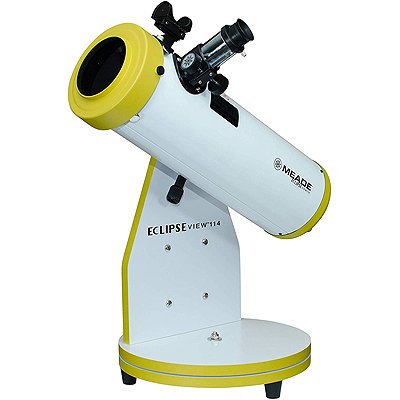
This certainly gave the best of both worlds. For ease of use, it has a night-time Red Dot and a day-Time Sun Finder.
It comes with two eyepieces, a 26mm a 9mm. The swivel mount stands on a table and moves through 360°. The point-and-view design was great for easy viewing.
We saw fabulous views of the moon, planets, nebulae, and the sun. I was very pleased to know that it has CE & ISO Certification for safe viewing of the sun.
Check the price of Meade Instruments EclipseView 114mm Telescope here
What we liked
- Great price for beginners
- Day and night viewing
- 2 eyepieces, 26mm and 9mm
- Easy to transport
- CE & ISO Certified
What we didn’t like
- Too simple for a professional
- Instruction manual may be tricky to understand
Aperture: 114mm
Focal Length: 450mm
Magnification: 11x and 35x
Lens: 114mm
Weight: 10.8 pounds
Dimensions: 12.2 x 12.2 x 24 inches
2. Sky-Watcher Virtuoso Telescope
The Sky-Watcher Virtuoso is great for a beginner wanting a telescope with advanced features at a very affordable price.
It stands on an alt-azimuth table mount, which we found very easy to use. It also has a mounting bracket if you want to attach it to a tripod.
The scope has a 90mm lens and a 5×24 finder scope. It features a bracket for DSLR (Digital Single Lens Reflex) cameras, a camcorder, and a mobile phone.
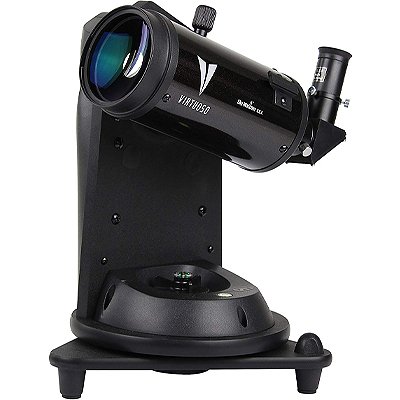
This was the first motorized telescope we reviewed. We were soon enjoying the automated functionality as it tracked our sky object without manual intervention.
We also tried our skills at astrophotography. The family was proud of the results! For safe viewing of the sun, there is a Solar filter and Solar finder.
The Sun Dual Axis Encoders allows you to move the mount by hand without losing the alignment. It comes with two eyepieces, a 10mm and 20mm 1.25″.
Check the price of Sky-Watcher Virtuoso Telescope here
What we liked
- Well priced for beginners
- Day and night viewing
- 2 eyepieces, 10mm and 20mm 1.25”
- Easy to transport
- Bracket for DSLR, camcorder and cell phone
What we didn’t like
- Instruction manual tricky to understand
Aperture: 90mm
Focal Length: 1250mm
Magnification: 13x
Lens: 90mm
Weight: 17 pounds
Dimensions: 14 x 14 x 19 inches
3. Meade Instruments Cornado PST Personal Solar Telescope
The Meade Instruments Cornado PST Personal Solar Telescope has a price in the middle range and is made specifically for viewing the sun.
It does not come with a mount, so you would need to purchase a separate one, or use a normal camera tripod.
The PST, Personal Solar Telescope, features a 40mm lens and a 400mm focal length.
For viewing of the sun, it has built-in filtering optics for ultra-safe viewing.

On a technical note, inside is a 1.0-angstrom hydrogen-alpha (Ha) bandpass, which gives exceptionally clear detail of the sun. We were able to see filaments and surface details, something we had never seen before!
Included with the scope is an 18mm plössl eyepiece. If you want to add extra accessories, you can purchase the gold CEMAX eyepieces separately.
Check the price of Meade Instruments Cornado PST Telescope here
What we liked
- Specifically for solar viewing
- Internal filtering optics for safe viewing
- Built in Sol Ranger
- Great views of the sun
- Easy to use built-in solar viewfinder
What we didn’t like
- Mount not included
- No viewing of the night sky
Aperture: 40mm
Focal Length: 400mm
Magnification: 10x
Lens: 40mm
Weight: 3.2 pounds
Dimensions: 11 x 8 x 20 inches
4. Lunt Solar 50mm H Alpha Telescope
The Lunt Solar Telescope 50mm H Alpha is a professional solar telescope built for beginners.
We were very impressed with the precision and features of this model.
It is higher priced but will become a lifetime purchase for those astronomers who have a special interest in the sun.
The telescope has a 50mm lens and a 350mm focal length. There is a special Blocking Filter 12mm eyepiece for safe viewing of the sun.
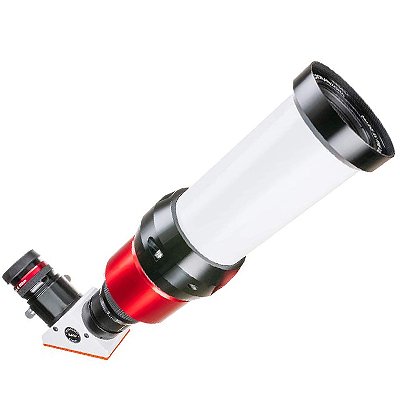
It also comes with a Helical Focuser and a Lunt Solar eyepiece. It is ready-to-view and does not require complex set up or alignment.
We found the telescope to be lightweight and easy to pack into the car to take on vacation. It comes with a very handy aluminum case. It does not have a mount, so you need to purchase one separately.
Check the price of Lunt Solar 50mm H Alpha Telescope here
What we liked
- Powerful solar telescope for amateurs
- B400 Solar Blocking Filter
- Easy set up and ready-to-view
- Aluminum case for transporting
- Exceptional solar views
What we didn’t like
- Higher price
- Mount not included
Aperture: 50mm
Focal Length: 350mm
Magnification: 7x
Lens: 50mm
Weight: 13.75 pounds
Dimensions: 23 x 15.8 x 9.2 inches
5. Meade Instruments 0.5PST Coronado H-Alpha Personal Solar Telescope
If you are serious about solar astronomy, this is the scope for you.
It has a high price but offers a professional instrument that will last a lifetime.
This Personal Solar Telescope has a 40mm aperture and a 400mm focal length. Solar viewing is safe with built-in filtering optics.
It features a 0.5-angstrom hydrogen-alpha (Ha) bandpass and comes with a black 18mm plössl eyepiece.
For easy viewing, there is a built-in Sol Ranger viewfinder.
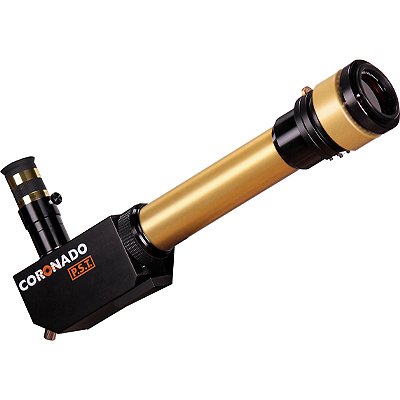
We were impressed by the additional filter, which makes the scope double stacked. It narrows the sunlight wavelength more than the single filter, bringing out incredible detail on the sun’s surface.
We could also choose to use the single filter to view solar prominences on the outer edge of the disc. You will need to buy a mount, as it does not come supplied with one.
Check the price of Meade Instruments 0.5PST Coronado H-Alpha here
What we liked
- Specifically for solar viewing
- Internal filtering optics for safe viewing
- Built in Sol Ranger
- Great views of the sun
- Easy to use built-in solar viewfinder
What we didn’t like
- High price for a beginner
- Mount not included
Aperture: 40mm
Focal Length: 400mm
Magnification: 10x
Lens: 40mm
Weight: 6 pounds
Dimensions: 20 x 8 x 11 inches
Also read:

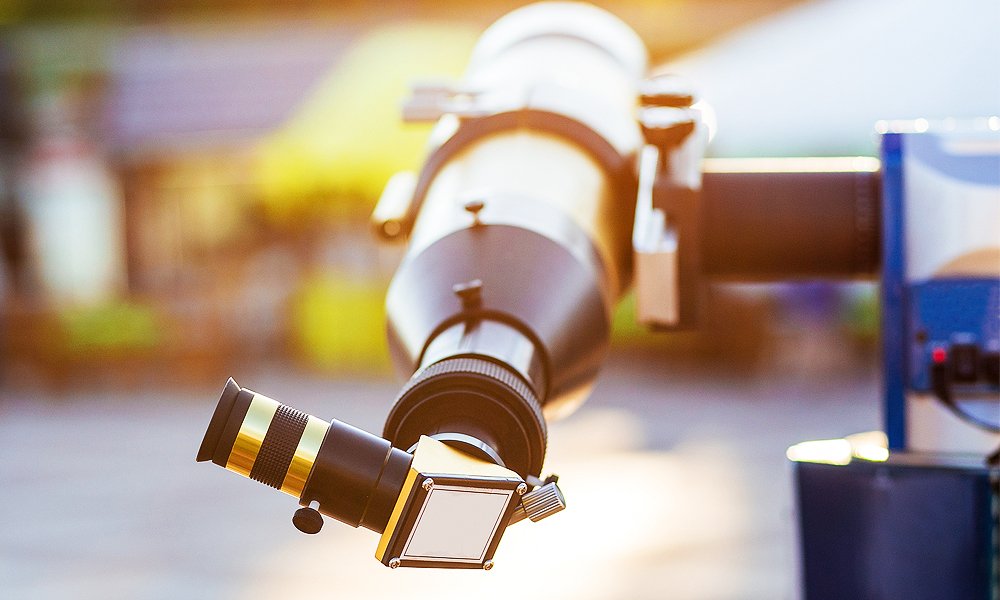
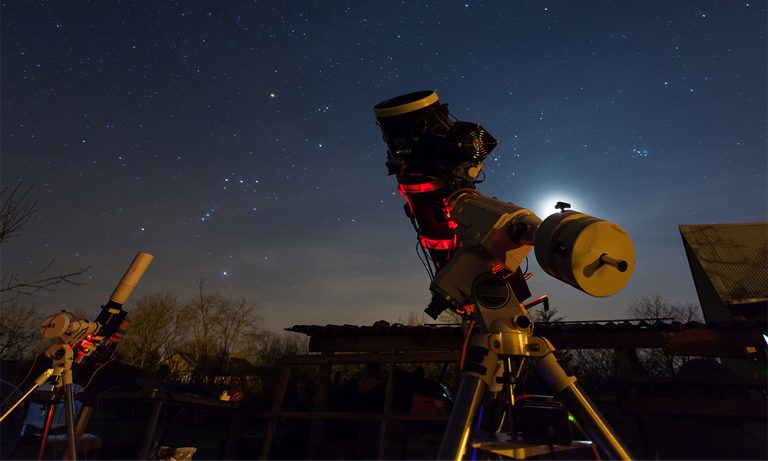
![12 Best Telescopes for Viewing Planets and Galaxies [2024]](https://www.planetguide.net/wp-content/uploads/2019/12/Depositphotos_144986289_l-2015-768x512.jpg)
![12 Best Telescopes for Kids in 2024 [Toddlers to Teens]](https://www.planetguide.net/wp-content/uploads/2019/12/Depositphotos_2254021_l-2015-768x512.jpg)
